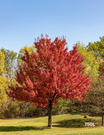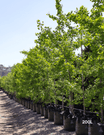As the chill of winter begins to fade and the promise of warmer days looms on the horizon, it’s time to start thinking about getting your garden ready for the vibrant season of spring. Whether you’re a seasoned gardener or a newcomer to the world of greenery, having the right tools is essential for creating a thriving and beautiful garden. This blog post will guide you through the top five essential tools to prepare your garden for spring. We'll also explore how these tools can help nurture the Crepe Myrtle, Camellia Setsugekka, and Magnolia Little Gem trees in your garden.
1. Pruners: Shaping Your Garden's Future
A good pair of pruners is one of the most fundamental tools in any gardener's arsenal. As spring approaches, many plants will show new growth, including your beloved Magnolia grandiflora 'Little Gem'. Pruners allow you to trim away dead or damaged branches, helping your trees and shrubs focus their energy on healthy growth.
Why Pruning is Essential for Spring Preparation
- Promotes Healthy Growth: Pruning in late winter or early spring encourages robust growth by removing deadwood and encouraging new buds.
- Improves Air Circulation: Trimming back dense areas ensures better airflow, reducing the risk of fungal infections and promoting healthier plants.
- Shape Plants: Pruning allows you to maintain the desired shape of your trees and shrubs, ensuring they grow harmoniously with your garden’s aesthetic.
When pruning your Camellia sasanqua 'Setsugekka', remove any crossing or crowded branches. This will enhance its natural beauty and ensure a profusion of white, ruffled blooms when spring arrives.

2. Spades: Digging the Foundation for Success
No garden is complete without a sturdy spade. This versatile tool is indispensable for planting new trees, digging trenches for irrigation, or edging garden beds. As you prepare your garden for spring, a spade will help you create the perfect environment for your Crepe Myrtle (Lagerstroemia indica).
How a Spade Can Transform Your Garden
- Planting: A spade is essential for digging holes that are the right size for new trees and shrubs, ensuring they have plenty of space to establish strong root systems.
- Soil Improvement: Use a spade to turn over soil, incorporating compost or other organic matter to improve soil fertility and structure.
- Edging: Use a spade to define the edges of your garden beds, creating clean lines that prevent grass and weeds from encroaching on your plants.
When planting a Crepe Myrtle, ensure that the hole you dig is twice as wide as the root ball but no deeper than its height. This will give the tree the best start in its new location.

3. Mulchers: Nourishing the Soil
Mulching is a critical practice for any gardener looking to prepare for spring. A mulcher helps you recycle garden waste into nutrient-rich mulch, which can be spread around your trees and shrubs to retain moisture, suppress weeds, and enrich the soil.
The Benefits of Mulching for Spring Gardens
- Moisture Retention: Mulch helps keep the soil moist, reducing the need for frequent watering, which is especially important during dry spells.
- Weed Suppression: A thick layer of mulch prevents weeds from taking root, reducing competition for nutrients and water.
- Soil Enrichment: As mulch breaks down, it adds organic matter to the soil, improving its fertility and structure.
Spread a layer of mulch around your Magnolia Little Gem to protect its shallow roots from temperature fluctuations and to provide a steady supply of nutrients as the mulch decomposes.

4. Garden Forks: Aerating and Loosening the Soil
A garden fork is another essential tool for preparing your garden for spring. It’s perfect for loosening compacted soil, which can impede root growth and water penetration. This tool is particularly useful for areas where you plan to plant new trees or shrubs.
Using a Garden Fork to Prepare the Soil
- Aeration: A garden fork allows you to poke holes in the soil, improving air circulation and water infiltration, which are crucial for root health.
- Loosening Soil: If your soil is heavy and compacted, a garden fork can break it up, making it easier for roots to grow and for water and nutrients to reach them.
- Incorporating Organic Matter: Use a garden fork to mix compost or other amendments into the soil, enhancing its fertility and structure.
For your Camellia Setsugekka, use a garden fork to gently aerate the soil around its roots, ensuring it has the best conditions to produce its stunning blooms.
5. Garden Trowels: Precision Planting
Finally, no gardener should be without a garden trowel. This small but mighty tool is perfect for planting bulbs, seedlings, and small plants and transplanting and dividing perennials.
The Versatility of a Garden Trowel
- Planting Bulbs and Seeds: A trowel allows you to dig small holes at the correct depth for planting bulbs and seeds, ensuring they get off to a good start.
- Transplanting: Use a trowel to carefully lift and transplant young plants or seedlings without damaging their roots.
- Weeding: A trowel can also dig out small weeds, ensuring they don’t compete with your garden plants for nutrients and water.
When planting new Magnolia Little Gem or Crepe Myrtle seedlings, a garden trowel will help you position them perfectly, giving them the best start in your spring garden.
FAQs About Spring Garden Preparation
Q: When is the best time to prepare my spring garden?
A: Late winter to early spring is ideal for garden preparation. This is the time to prune, mulch, and plant early spring bloomers.
Q: How much mulch should I apply around my trees?
A: Apply a 2-4 inch layer of mulch around your trees, taking care not to pile it against the trunk, which can cause rot.
Q: Can I use a garden fork on all soil types?
A: Garden forks are best for loosening compacted soil, particularly clay-heavy soils. However, they can be used on most soil types to improve aeration.







































Leave a comment
This site is protected by hCaptcha and the hCaptcha Privacy Policy and Terms of Service apply.